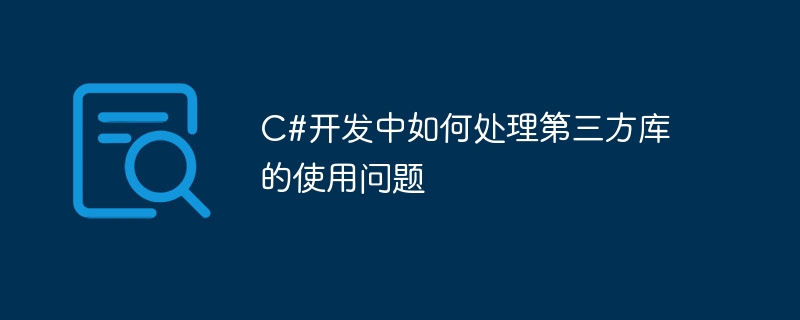
C#开发中如何处理第三方库的使用问题
引言:
在C#开发中,使用第三方库可以提高开发效率,拓宽功能范围,并且常常可以避免重新发明轮子的尴尬。然而,使用第三方库也会带来一些问题,如版本兼容性、文档不全等。本文将介绍一些常见的处理第三方库使用问题的方法,并提供相应的代码示例。
一、选择合适的第三方库
在使用第三方库之前,首先需要进行合理的选择。以下是一些参考标准:
选择合适的第三方库是解决问题的关键,避免了后期使用过程中可能出现的问题。
二、保持库的更新与版本控制
第三方库通常会随着时间的推移而更新。为了解决可能出现的版本兼容性问题,我们可以使用以下方法:
以下是使用NuGet管理器进行第三方库的安装和更新的示例代码:
using System;
using System.Collections.Generic;
using System.Linq;
using System.Text;
using System.Threading.Tasks;
using NuGet;
namespace NuGetExample
{
class Program
{
static void Main(string[] args)
{
// 定义NuGet管理器
var packageManager = new PackageManager(
new PackageRepositoryFactory().CreateRepository("https://www.nuget.org/api/v2"),
"./packages"
);
// 安装第三方库
packageManager.InstallPackage("Newtonsoft.Json");
// 更新第三方库
packageManager.UpdatePackage("Newtonsoft.Json");
}
}
}三、处理第三方库缺失的文档和示例问题
有时候,我们可能会遇到一些第三方库缺失或者不完善的文档和示例。以下是一些建议来解决这些问题:
解决问题的关键在于多方寻找信息,并能够合理地利用已有的资源。
结论:
在C#开发中,使用第三方库可以提高开发效率和功能拓展性,但也会带来一些问题。选择合适的第三方库、保持库的更新与版本控制,以及解决库缺失的文档和示例问题,能够帮助我们更好地处理第三方库的使用问题。通过这些方法,能够有效避免因第三方库使用不当而造成的问题,提高开发效率和代码质量。
参考文献:
(字数:819)
以上就是C#开发中如何处理第三方库的使用问题的详细内容,更多请关注php中文网其它相关文章!

每个人都需要一台速度更快、更稳定的 PC。随着时间的推移,垃圾文件、旧注册表数据和不必要的后台进程会占用资源并降低性能。幸运的是,许多工具可以让 Windows 保持平稳运行。

Copyright 2014-2025 //m.sbmmt.com/ All Rights Reserved | php.cn | 湘ICP备2023035733号